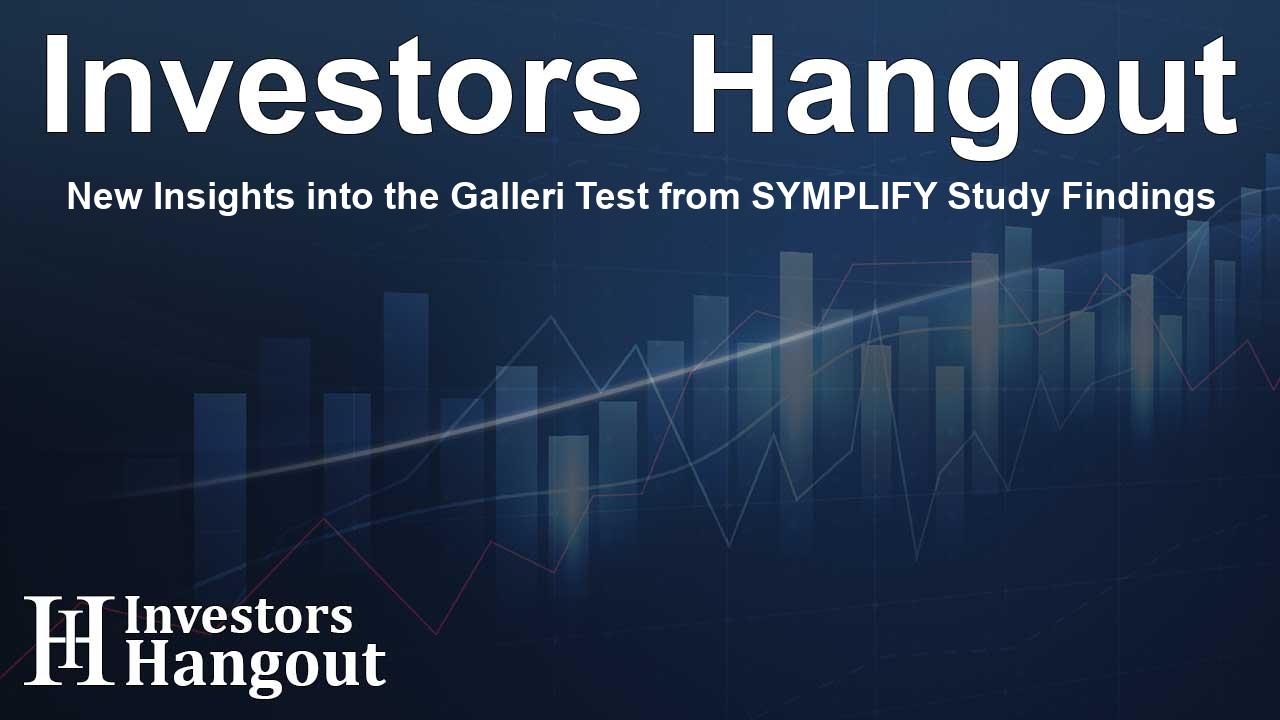New Insights into the Galleri Test from SYMPLIFY Study Findings

Long-Term Findings from the SYMPLIFY Study
GRAIL, Inc. (Nasdaq: GRAL), a pioneer in early cancer detection, and the University of Oxford recently revealed significant long-term outcomes from the SYMPLIFY study. This study showcases the effectiveness of the Galleri multi-cancer early detection test, particularly among symptomatic individuals. The details of this extensive analysis are set to be discussed at the upcoming Early Detection of Cancer Conference (EDCC).
A Shift in Understanding False-Positive Results
In an insightful update, it was found that a third of individuals initially suspected of receiving false-positive results from the Galleri test were later diagnosed with cancer. This revelation emphasizes the critical need for thorough follow-up assessments for individuals who encounter positive results. Brian D. Nicholson, a key investigator from the University of Oxford, indicated that these findings underline the importance of proactive medical evaluations following positive results from the multicaner early detection (MCED) tests.
Improved Positive Predictive Value
The Galleri test's positive predictive value (PPV) in this symptomatic population has seen an impressive rise to 84.2%. This improvement arises from the study of 79 participants who had initially received false-positive results yet were later confirmed as cancer cases within a follow-up period. Notably, the Galleri test was able to accurately predict the cancer signal origin (CSO) in nearly all these instances, highlighting its utility as a predictive tool in the diagnostic process.
Understanding the SYMPLIFY Study
The SYMPLIFY study marked a milestone as one of the first extensive observational studies evaluating the MCED test in symptomatic patients. It analyzed over 6,000 blood samples collected from individuals presenting with cancer symptoms, adhering to standard medical diagnostic protocols. This non-interventional approach meant that physicians were unaware of the Galleri test results, preserving the impartiality of the diagnostic evaluations.
Key Outcomes and Insights
The results from this advanced study demonstrated that many participants went on to be diagnosed with cancers that standard diagnostic pathways failed to detect early. For instance, among those originally labeled as having false positives, 57.1% were diagnosed within nine months and 42.9% were diagnosed in the following months. Of particular interest was the fact that the cancer diagnosis did not always correlate with the initial referral pathway followed by the general practitioners.
Implications for Future Cancer Screening
The findings from SYMPLIFY not only illustrate the potential of the Galleri test but also set the stage for integrating such tests into standard diagnostic practices. Sir Harpal Kumar, from GRAIL, noted that the information derived from this study bolsters the argument for continued follow-up, which can be critical in addressing cancers that might initially evade detection during standard evaluations. The ability of the Galleri test to provide insights into cancer types even in cases of non-specific symptoms underlines its promise for improving early cancer detection.
About GRAIL and the Galleri Test
GRAIL is dedicated to revolutionizing the early detection of cancer through advanced technologies and innovative research. The Galleri test, uniquely designed, can screen for over 50 cancer types through a simple blood draw. By identifying cancer signals before overt symptoms emerge, the test provides a valuable tool for proactive cancer management, especially for individuals over 50 who are at a higher risk.
The Role of Galleri in Healthcare
The integration of Galleri into clinical practice can vastly improve the efficiency of cancer screenings alongside existing methods such as mammograms and colonoscopies. This reduction of false positives, coupled with precise cancer signal predictions, can significantly enhance patient outcomes. GRAIL continues to lead in using cutting-edge technologies to aid healthcare providers in making timely, informed decisions regarding patient care.
Frequently Asked Questions
What is the Galleri test?
The Galleri test is a blood-based test that can detect more than 50 types of cancer in their early stages.
What were the key findings from the SYMPLIFY study?
The SYMPLIFY study found that a significant number of individuals initially thought to have false-positive results were actually diagnosed with cancer.
How does the Galleri test provide cancer signal origin information?
The Galleri test analyzes methylation patterns in DNA, helping to pinpoint where in the body a cancer might be occurring.
What is the significance of the positive predictive value reported?
The positive predictive value of 84.2% showcases the Galleri test's reliability in identifying true malignancies among symptomatic individuals.
How can the findings impact future cancer screening protocols?
The findings emphasize the necessity for an integrated approach to cancer screening, encouraging proactive follow-up and utilization of advanced diagnostic tools like Galleri.
About The Author
Contact Logan Wright privately here. Or send an email with ATTN: Logan Wright as the subject to contact@investorshangout.com.
About Investors Hangout
Investors Hangout is a leading online stock forum for financial discussion and learning, offering a wide range of free tools and resources. It draws in traders of all levels, who exchange market knowledge, investigate trading tactics, and keep an eye on industry developments in real time. Featuring financial articles, stock message boards, quotes, charts, company profiles, and live news updates. Through cooperative learning and a wealth of informational resources, it helps users from novices creating their first portfolios to experts honing their techniques. Join Investors Hangout today: https://investorshangout.com/
The content of this article is based on factual, publicly available information and does not represent legal, financial, or investment advice. Investors Hangout does not offer financial advice, and the author is not a licensed financial advisor. Consult a qualified advisor before making any financial or investment decisions based on this article. This article should not be considered advice to purchase, sell, or hold any securities or other investments. If any of the material provided here is inaccurate, please contact us for corrections.
